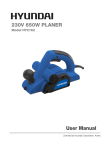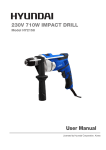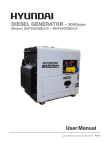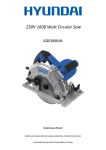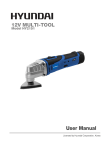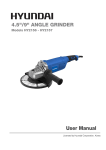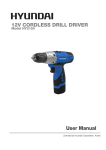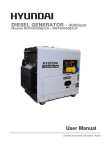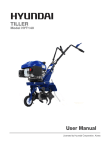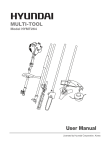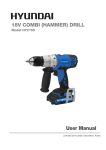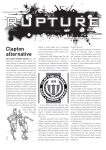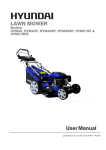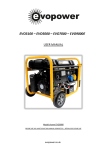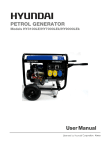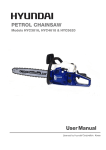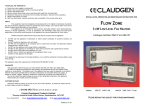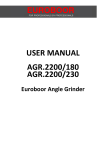Download User Manual - Sitebox Ltd
Transcript
230V 710W JIGSAW Model HY2161 User Manual CONTENTS Section Description Page No/No’s 1. OWNER’S MANUAL & SAFETY INSTRUCTIONS 3 2. SPECIFIC SAFETY INSTRUCTIONS 3 3. GENERAL SAFETY 4. QUICK REFERENCE GUIDE AND USE 5. UNPACKING & ASSEMBLY 6. OPERATION 4–5 6 6–8 9 – 10 7. GENERAL MAINTENANCE 10 8. SYMBOLS 10 9. ENVIRONMENTAL 11 10. GENPOWER CONTACT DETAILS 11 11. DECLARATIONS OF CONFORMITY 11 Page 2 1. OWNER’S MANUAL & SAFETY INSTRUCTIONS 1.1. How to read the manual. 1.1.1. Keep this manual for the safety warnings and precautions, assembly, operation, inspection, maintenance and cleaning procedures. 1.1.2. Write the product’s serial number in the back of the manual near the assembly diagram (or month and year of purchase if product has no number). 1.1.3. Keep this manual and the receipt in a safe and dry place for future reference. 1.1.4. The term “power tool” in the warnings refers to your mains operated (corded) power tool or battery-operated (cordless) power tool. 1.1.5. This Jigsaw is intended for cutting materials within the selected blade and the machines capability. 2. GENERAL SAFETY Non-observance will result in the risk of serious injury or death to oneself or others. Non- observance will result in the risk of injury to oneself or others. Indicates a hazard which, if not avoided, might result in minor or moderate injury. NOTE or IMPORTANT These give details or further information on what has already been said, and aim to prevent damage to the machine or cause other damage. Read Manual This machine requires the use of two hands to ensure safe operation DO NOT let comfort or familiarity with product (gained from repeated use) replace strict adherence to safety rules for the subject product. MISUSE or failure to follow the safety rules stated in this instruction manual may cause serious personal injury. 2.1. Work Area Safety 2.1.1. Keep work area clean and well lit. Cluttered or dark areas invite accidents. 2.1.2. Do not operate power tools in explosive atmospheres, such as in the presence of flammable liquids, gases or dust. Power tools create sparks which may ignite the dust or fumes. 2.1.3. Keep children and bystanders away while operating a power tool. Distractions can cause you to lose control. 2.2. Electrical Safety. 2.2.1. Power tool plugs must match the outlet. Never modify the plug in any way. Do not use any adapter plugs with earthed (grounded) power tools. Unmodified plugs and matching outlets will reduce risk of electric shock. 2.2.2. Avoid body contact with earthed or grounded surfaces, such as pipes, radiators, ranges and refrigerators. There is an increased risk of electric shock if your body is earthed or grounded. Page 3 2.2.3. Do not expose power tools to rain or wet conditions. Water entering a power tool will increase the risk of electric shock. 2.2.4. Do not abuse the cord. Never use the cord for carrying, pulling or unplugging the power tool. Keep cord away from heat, oil, sharp edges and moving parts. Damaged or entangled cords increase the risk of electric shock. 2.2.5. When operating a power tool outdoors, use an extension cord suitable for outdoor use. 2.2.6. Use of a cord suitable for outdoor use reduces the risk of electric shock. 2.2.7. If operating a power tool in a damp location is unavoidable, use a residual current device (RCD) protected supply. Use of an RCD reduces the risk of electric shock. 2.3. Personal Safety. 2.3.1. Stay alert, watch what you are doing and use common sense when operating a power tool. Do not use a power tool while you are tired or under the influence of drugs, alcohol or medication. A moment of inattention while operating power tools may result in serious personal injury. 2.3.2. Use personal protective equipment. Always wear eye protection. Protective equipment such as dust mask, non-skid safety shoes, hard hat, or hearing protection used for appropriate conditions will reduce personal injuries. 2.3.3. Prevent unintentional starting. Ensure the switch is in the off-position before connecting to power source and/or battery pack, picking up or carrying the tool. Carrying power tools with your finger on the switch or energizing power tools that have the switch on invites accidents. 2.3.4. Remove any adjusting key or wrench before turning the power tool on. A wrench or a key left attached to a rotating part of the power tool may result in personal injury. 2.3.5. Do not overreach. Keep proper footing and balance at all times. This enables better control of the power tool in unexpected situations. 2.3.6. Dress properly. Do not wear loose clothing or jewellery. Keep your hair, clothing and gloves away from moving parts. Loose clothes, jewellery or long hair can be caught in moving parts. 2.3.7. If devices are provided for the connection of dust extraction and collection facilities, ensure these are connected and properly used. Use of dust collection can reduce dust-related hazards. 2.4. Power Tool Use and Care. 2.4.1. Do not force the power tool. Use the correct power tool for your application. The correct power tool will do the job better and safer at the rate for which it was designed. 2.4.2. Do not use the power tool if the switch does not turn it on and off. Any power tool that cannot be controlled with the switch is dangerous and must be repaired. 2.4.3. Disconnect the plug from the power source and/or the battery pack from the power tool before making any adjustments, changing accessories, or storing power tools. Such preventive safety measures reduce the risk of starting the power tool accidentally. 2.4.4. Store idle power tools out of the reach of children and do not allow persons unfamiliar with the power tool or these instructions to operate the power tool. Power tools are dangerous in the hands of untrained users. 2.4.5. Maintain power tools. Check for misalignment or binding of moving parts, breakage of parts and any other condition that may affect the power tool’s operation. If damaged, have the power tool repaired before use. Many accidents are caused by poorly maintained power tools. 2.4.6. Keep cutting tools sharp and clean. Properly maintained cutting tools with sharp cutting edges are less likely to bind and are easier to control. Page 4 2.4.7. Use the power tool, accessories and etc. in accordance with these instructions, taking into account the working conditions and the work to be performed. 2.4.8. Use of the power tool for operations different from those intended could result in a hazardous situation. 2.5. Service. 2.5.1. Have your power tool serviced by a qualified repair person using only identical replacement parts. This will ensure that the safety of the power tool is maintained. 3. QUICK REFERENCE GUIDE and USE PARTS 1 Variable Speed Control. 2 Lock Button. 3 ON/OFF Switch. 4 Quick Change Blade holder. 6 Base plate release lever. 7 Blower control. 8 Five Position Pendulum Control. 9 Vacuum Connection Point. 5 Base plate – Bevel cuts up to 45° Left & Right. 10 Power Indicator Lamp. TECHNICAL SPECIFICATION Rated Voltage. 230V – 50 Hz. Rated Power. 710 Watts. 1000 – 2,800 strokes/min. TU. No Load Speed. Blade Holder Type Net Weight (Machine Only). Sound Pressure Level. Sound Power Level. 2.62 Kg 88 dB (LpA) 99 dB (LwA) Page 5 4. UNPACKING and ASSEMBLY This packaging contains sharp objects. Take care when unpacking. Remove the machine, together with the accessories supplied, from the packaging. 4.1. Unpacking. 4.1.1. Check carefully to ensure that the machine is in good condition and account for all the accessories listed in this manual. 4.1.2. If any parts are found to be missing, the machine and its accessories should be returned together in their original packaging to the retailer. 4.1.3. Do not throw the packaging away, keep it safe throughout the guarantee period, then recycle if possible, otherwise dispose of it by the proper means. 4.1.4. Do not let children play with empty plastic bags due to the risk of suffocation. 4.2. Assembly Before carrying out any assembly or disassembly of the unit please ensure that the unit is not connected to the electrical supply. 4.3. Installing or Removing saw blades. Always clean out all chips or foreign matter adhering to the blade and/or blade holder. Occasionally lubricate the roller. 4.3.1. Failure to clean out all chips or foreign matter adhering to the blade and/or blade holder may cause insufficient tightening of the blade, resulting in a serious personal injury. 4.3.2. Do not touch the blade or the work piece immediately after operation; they may be extremely hot and could cause burns. 4.3.3. Always secure the blade firmly. Insufficient tightening of the blade may cause blade breakage or serious personal injury. To install the blade, press the clamp on the blade holder then insert the blade into the holder, then release the clamp, the blade can be set firmly; 4.3.4. To install the blade loosen both bolts counter clockwise on the blade holder with the hex wrench. 4.3.5. With the blade teeth facing forward, inset the blade into the blade holder as far as it will go. Make sure that the back edge of the blade fits into the roller. Then tighten both bolts clockwise to secure the blade. 4.3.6. To remove the blade, follow the installation procedure in reverse. 5. OPERATION Page 6 Jig saw can produce fine dust that could ignite in the presence of sparks or an open flame. To avoid injury, always use the jigsaw in a well-ventilated area. 5.1. Switch action. 5.1.1. Before plugging in the tool, always check to see that the switch trigger works properly and returns to the off position when released. 5.1.2. The switch can be locked for ease of operator comfort during extended use. Apply caution when locking tool and maintain a firm grasp on tool. 5.1.3. To start the tool, simply pull the switch trigger. To stop release the switch trigger. 5.1.4. For continuous operation, pull the switch trigger and then push in the lock button. 5.1.5. To stop the tool from the locked position, pull the switch trigger fully, then release it. 5.2. Speed Adjusting Dial. 5.2.1. The tool speed can be infinitely adjusted between 1,000 and 2,800 strokes per minute by turning the adjusting dial. 5.2.2. Higher speed is obtained when the dial is turned in the direction of number 6, lower speed is obtained when it is turned in the direction of number 1. 5.2.3. However, the appropriate speed may differ with the type or thickness of the work piece. In general, higher speeds will allow you to cut work pieces faster but service life of the blade will be reduced. 5.3. Cutting bevel - Angle adjustment. 5.3.1. To adjust the bevel angle loosen the screws on the steel base with the provided Allen Key, then adjust the base to desire angle, then to tighten the screws on the base by the Allen Key. Page 7 6. GENERAL MAINTENANCE Turn OFF and unplug the power cord before maintaining the jigsaw. Do not at any time let brake fluids, petrol, petroleum based products, penetrating oils, etc., come in contact with plastic parts. Chemicals can damage, weaken or destroy plastic which may result in serious personal injury. 6.1. Keep this power tool clean and in good repair for maximum performance and longevity. 6.2. Before each use, check for damaged, missing, or worn parts. 6.3. Check for loose screws, misalignment, or binding of moving parts, or any other conditions that may affect the operation. If abnormal vibration or noise occurs, turn the tool off immediately and correct the problem. Avoid using solvents when cleaning plastic parts. 6.4. Cleaning. 6.4.1. Clean dust and debris from the air vents. 6.4.2. Frequently remove dust from the motor area using an air compressor or dust vacuum. 6.4.3. Keep the tool clean, dry, and free of oil and grease. 6.4.4. Use only mild soap and a damp cloth to clean this tool. 6.4.5. Certain cleaning agents are harmful to plastic and other insulated parts. Do not use petrol, turpentine, lacquer thinner, paint thinner, chlorinated cleaning solvents, ammonia, or household cleaning detergents containing ammonia. 6.5. Lubrication. 6.5.1. This tool has been lubricated at the factory. Under normal use, it will not need further lubrication. 7. SYMBOLS Page 8 7.1. The rating plate on this product may show some or all of the following symbols. 7.2. These represent important information about the product or instructions on its use. Wear hearing protection. Wear eye protection. Wear respiratory protection. Product conforms to RoHs requirements Conforms to relevant safety standards. General warning Double insulated for additional protection. Read the instruction manual. Waste electrical products should not be disposed of with household waste. Please recycle where facilities exist. Check with your Local Authority or retailer for recycling advice. 8. ENVIRONMENTAL 8.1. Do not dispose of electric equipment together with household waste material! In observance of European Directive 2012/19/EC on waste electrical and electronic equipment and its implementation in accordance with national law, electric equipment that have reached the end of their life must be collected separately and returned to an environmentally compatible recycling facility. If electrical appliances are disposed of in landfills or dumps hazardous substances can leak into the groundwater and get into the food chain, damaging your health and well-being. 8.2. For further information on the disposal of this product, please contact your dealer or your nearest domestic waste collection service. 8.3. Reduce – Reuse - Recycle unwanted materials instead of disposing of them as waste. All tools, accessories and packaging should be sorted, taken to a recycling centre and disposed of in a manner which is compatible with the environment. 8.4. When the product is no longer required, it must be disposed of in a manner which is compatible with the environment. Page 9 9. GENPOWER CONTACT DETAILS 9.1. Postal address; Genpower Limited, Isaac Way, Pembroke Dock, Pembrokeshire, SA72 4RW, UK. 9.2. Telephone contact number; Office +44 (0) 1646 687880 9.3. Email contact; Technical [email protected] 9.4. Web site; www.hyundaipowerequipment.co.uk 10. DECLARATIONS OF CONFORMITY 10.1. Genpower Ltd confirms that this Hyundai product conform to the following CE Directives; 10.1.1. 2006/42/EC Machinery Directive 10.1.2. 2004/108/EC EMC Directive 10.1.3. 2006/95/EC Low Voltage Directive Page 10 Page 11 Page 12












